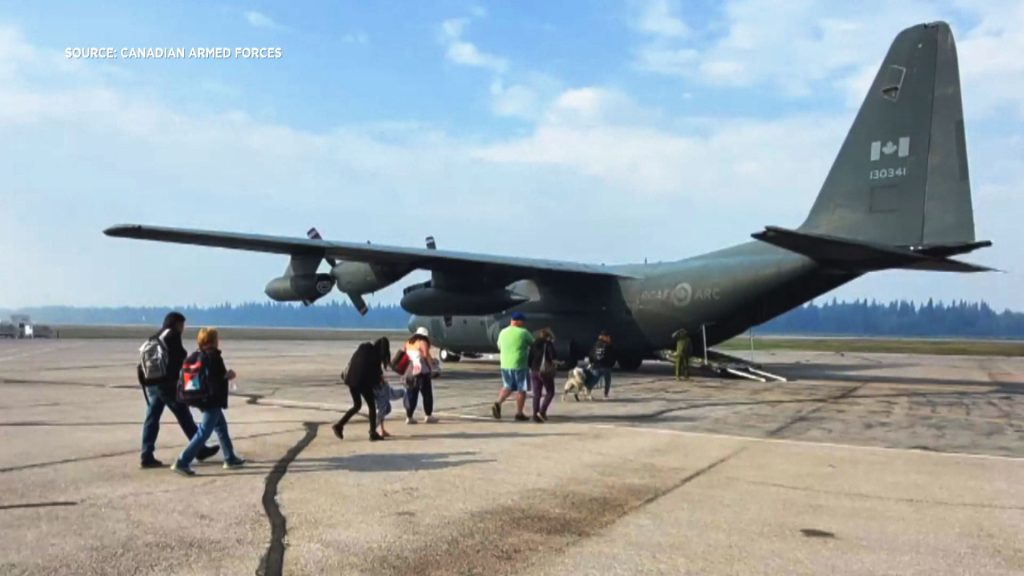
Evacuees head to a military plane as 20,000 residents are ordered to leave the capital of Yellowknife. Photo: CAF
Thousands of Yellowknife residents joined road convoys and stood with packed bags in snaking lines at the airport Thursday to flee a looming wildfire approaching the capital of the Northwest Territories.
The 20,000 residents of the city and two nearby First Nations have been ordered to be out by noon Friday while crews battle some of the more than 200 blazes that have forced thousands more to retreat to evacuation centres throughout Alberta as far south as Calgary.
Lifelong Yellowknifer Angela Canning had to make crucial decisions with the clock ticking.
“I’m really anxious and I’m scared. I’m emotional,” she said.
“God, just so many emotions I don’t even know where to begin. I’m in shock.”
Related links:
N.W.T. officials said the evacuation has so far been safe, with the fire about 16 kilometres from Yellowknife’s northern outskirts. The order was made, in part, to allow for an orderly exit while the fire is at a distance.
The evacuation ordered late Wednesday applies to Yellowknife as well as the nearby communities of Ndilo and Dettah.
Canning said her husband is staying behind as an essential worker, so she and the couple’s two dogs will head in their camper to Fort Providence, N.W.T., along with important documents, family keepsakes and basic necessities.
“I don’t know what I’m coming home to or if I’m coming home. There’s just so much unknowns here,” she said.
At Yellowknife’s Sir John Franklin high school, there was a kilometre-long lineup of residents who don’t have vehicles queuing up to get transported out by air.
Homeless shelters
Edward Fraser, along with dozens of others from the city’s homeless shelters, said they started to line up outside the school at 9:30 a.m.
“Been standing for two hours now and moved about a half a block,” Fraser said in a phone interview from the lineup.
Fraser said they were told they could take one bag with their belongings because of limited space.
“They closed the doors and locked up all our stuff we can’t take with us. All of us just have backpacks,” he said.
“Hopefully Calgary opens up their arms to us.”
Health authority
The N.W.T. health authority said surgeries are being reduced and some services at Yellowknife’s Stanton Territorial Hospital, including long-term care, were to be closed by Friday. Intensive care patients were being moved to Alberta.
Birthing services were to be reduced, but the emergency department is to stay open at normal service levels.
The territorial government postponed its legislature sitting set for Aug. 21. Transit, trucked water and sewer services, and residential garbage collection have been suspended.
N.W.T. fire information officer Mike Westwick said convoys were being organized by government emergency workers amid concerns strong north winds could push flames toward Highway 3, the main highway needed for the evacuation.
“It’s going to be tough to get this done, there’s no doubt, but folks are co-operating, folks are staying calm,” Westwick said. “People are doing the right thing.”
Gas station
At Fort Providence, 300 kilometres south of Yellowknife, Linda Croft of the Big River Service Station, the main gas station on the highway, said the lineup of vehicles was overwhelming.
“This is phenomenal – the amount of traffic,” Croft said. “It’s lined up way around the corner. You can’t see the end of it.”
People fuelling up were anxious, she said, but also trying to stay optimistic.
Other communities from Yellowknife south to the Alberta boundary ordered residents out earlier this week, including the hamlet of Enterprise, which is reported to have been decimated.
Travelling by air
Evacuees travelling by air to Alberta were being directed to Calgary and officials were trying to reserve seats for those with health problems, such as the immunocompromised. Canadian Forces personnel have already been busy this week helping firefighters and flying out evacuees on Hercules aircraft.
In Calgary, officials said reception centres have been set up to accommodate at least 5,000 people.
Iain Bushell, Calgary’s director of emergency management and community safety, said five evacuation flights were set to arrive Thursday.
“Accommodation will be provided through various hotels in Calgary,” Bushell said. “Additionally, we are working with our partners and our city shelters to accommodate pets with shelter or supplies as needed.”
Alberta Health Services is also placing continuing care evacuee residents in facilities.
Evacuation centres
Other Alberta evacuation centres were operating in Fox Creek, Valleyview and Grande Prairie in the north, along with St. Albert, Leduc and Red Deer in the central region.
Prime Minister Justin Trudeau, vacationing in Tofino, B.C., was expected to convene an urgent meeting with ministers and senior officials later Thursday.
Trudeau updated his itinerary to include an urgent meeting of the incident response group, a cabinet committee that typically consists of senior ministers and top officials.
The N.W.T. said 236 blazes were burning Thursday, including fires threatening Yellowknife and the town of Hay River.
Westwick said flames got within 10 kilometres of Hay River until the wind shifted and the fire “stopped in its tracks.”
The blazes have burned an area almost four times the size of Prince Edward Island. No deaths have been reported.









